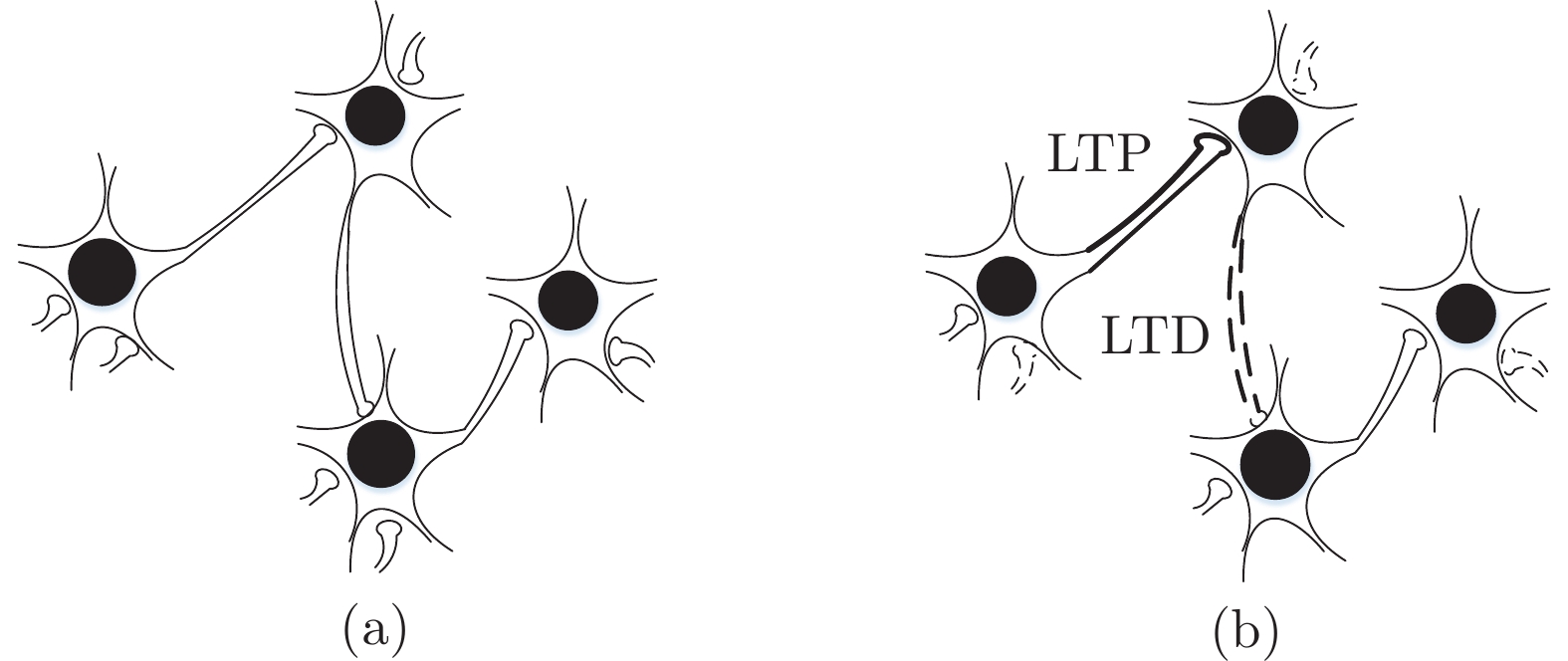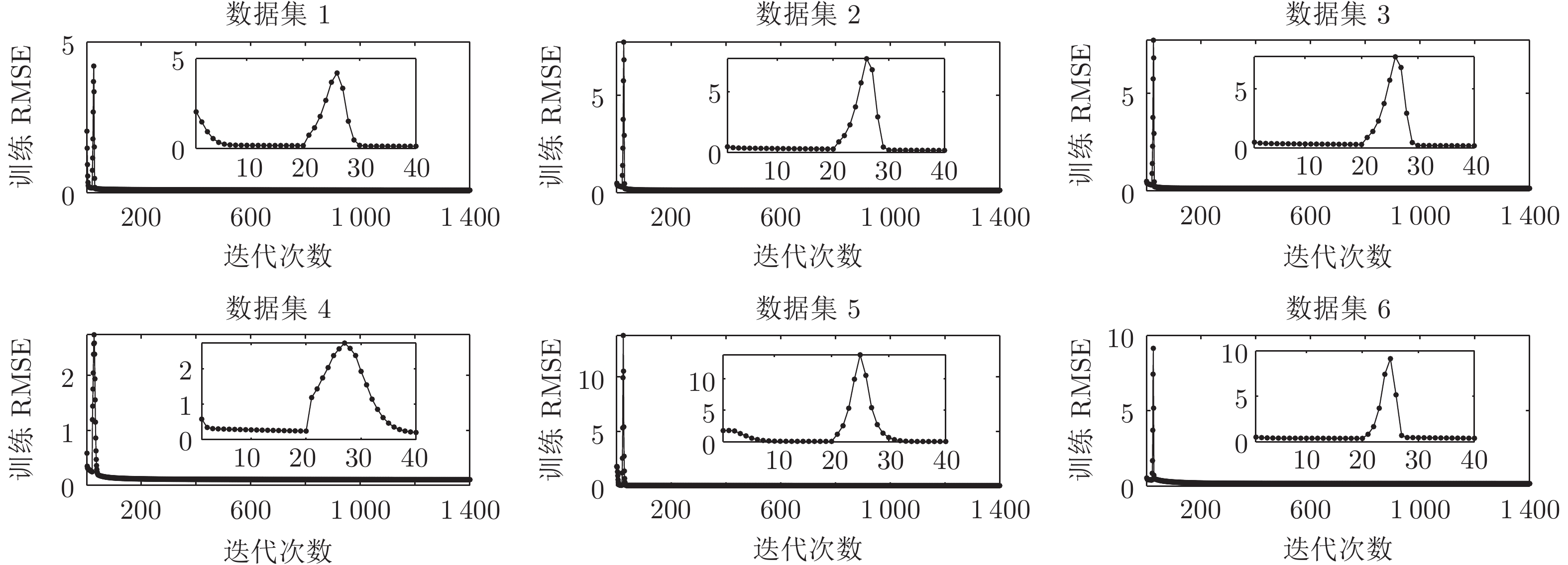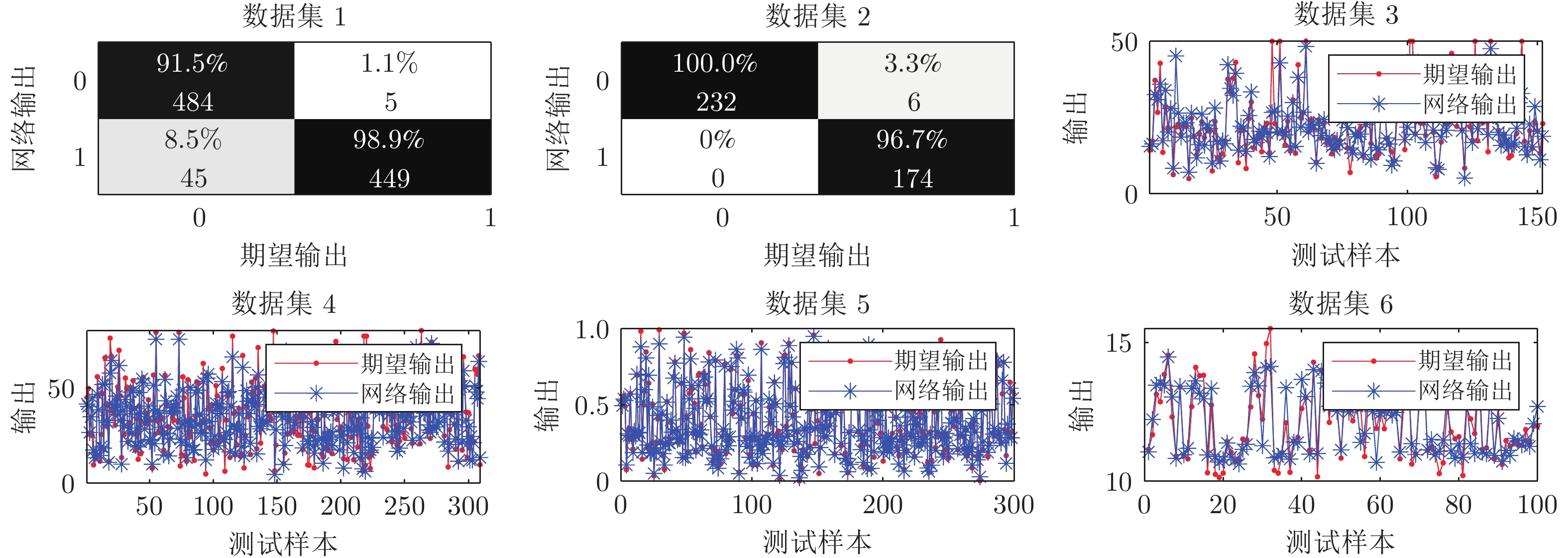Structure Design for Feedforward Small-world Neural Network Based on Synaptic Consolidation Mechanism
-
摘要: 小世界神经网络具有较快的收敛速度和优越的容错性, 近年来得到广泛关注. 然而, 在网络构造过程中, 随机重连可能造成重要信息丢失, 进而导致网络精度下降. 针对该问题, 基于Watts-Strogatz (WS) 型小世界神经网络, 提出了一种基于突触巩固机制的前馈小世界神经网络(Feedforward small-world neural network based on synaptic consolidation, FSWNN-SC). 首先, 使用网络正则化方法对规则前馈神经网络进行预训练, 基于突触巩固机制, 断开网络不重要的权值连接, 保留重要的连接权值; 其次, 设计重连规则构造小世界神经网络, 在保证网络小世界属性的同时实现网络稀疏化, 并使用梯度下降算法训练网络; 最后, 通过4个UCI基准数据集和2个真实数据集进行模型性能测试, 并使用Wilcoxon符号秩检验对对比模型进行显著性差异检验. 实验结果表明: 所提出的FSWNN-SC模型在获得紧凑的网络结构的同时, 其精度显著优于规则前馈神经网络及其他WS型小世界神经网络.
-
关键词:
- 小世界神经网络 /
- 突触巩固机制 /
- 网络正则化 /
- 重连规则 /
- Wilcoxon符号秩检验
Abstract: Because of faster convergence speed and superior fault tolerance, small-world neural network has attracted wide attention in recent years. However, in the construction process, it may cause the loss of important information due to random reconnection, which may lead to the decline of network accuracy. To solve this problem, derived from the Watts-Strogatz (WS) small-world neural network, a feedforward small-world neural network based on synaptic consolidation (FSWNN-SC) mechanism is proposed in this study. Firstly, the regular feedforward neural network is pre-trained by using the network regularization method. Based on the synaptic consolidation mechanism, the unimportant connection weights of the network are disconnected and the important connection weights are retained. Secondly, the rewiring rules are designed to construct a small-world neural network, which can realize the sparseness of the network while ensuring the small-world properties of the network. The gradient descent algorithm is used to train the network. Finally, four UCI benchmark experiments and two practical experiments are carried out to evaluate the model performance, and the Wilcoxon signed-ranks test is performed to test the significant differences between comparative models. Experimental results show that the FSWNN-SC model proposed in this study not only obtains a compact network structure, but also has significantly better accuracy than regular feedforward neural networks and other WS small-world neural networks. -
表 1 实验超参数设置
Table 1 Setting of the hyperparameters in experiments
数据集 网络结构 $\lambda$ $\mu$ $iter_{\mathrm{max}}$ $\mathrm{RMSE}_d$ 数据集1 8-15-15-1 $1.0\times10^{-3}$ 0.0003 6000 0.001 数据集2 4-15-15-1 $1.0\times10^{-3}$ 0.0008 6000 0.001 数据集3 13-20-20-1 $1.0\times10^{-6}$ 0.0008 10000 0.001 数据集4 8-20-20-1 $1.0\times10^{-6}$ 0.0008 10000 0.001 数据集5 6-20-20-1 $1.0\times10^{-6}$ 0.0005 10000 0.001 数据集6 10-20-20-1 $1.0\times10^{-6}$ 0.0008 10000 0.001 表 2 分类实验结果对比
Table 2 Comparison results in classification experiments
分类实验 网络 网络结构 稀疏度SP 测试 Acc 训练时间 (s) 均值 标准差 均值 标准差 数据集1 FSWNN-SC 8-15-12-1 0.8861 0.9472 0.0034 3.9631 0.1936 PFSWNN-SL 8-15-11-1 0.7511 0.9403 0.0026 5.6645 0.2085 PFSWNN-Katz 8-12-10-1 0.6056 0.9396 0.0126 4.0555 0.2764 FSWNN-TO 8-15-15-1 — 0.9392 0.0066 5.4922 0.0147 FSWNN-WS 8-15-15-1 — 0.9374 0.0073 3.9371 0.1255 FNN 8-15-15-1 — 0.9195 0.0093 3.7201 0.0609 数据集2 FSWNN-SC 4-15-12-1 0.8950 0.9883 0.0049 2.7552 0.4252 PFSWNN-SL 4-15-10-1 0.6608 0.9788 0.0081 4.6556 0.2525 PFSWNN-Katz 4-10-11-1 0.5463 0.9823 0.0054 2.8007 0.1837 FSWNN-TO 4-15-15-1 — 0.9840 0.0040 3.6596 0.0614 FSWNN-WS 4-15-15-1 — 0.9782 0.0071 2.3605 0.0419 FNN 4-15-15-1 — 0.9756 0.0132 2.3402 0.0347 表 3 回归实验结果对比
Table 3 Comparison results in regression experiments
回归实验 网络 网络结构 稀疏度SP 测试NRMSE 训练时间 (s) 均值 标准差 均值 标准差 数据集3 FSWNN-SC 13-20-13-1 0.7941 0.4331 0.0199 2.9838 0.0978 PFSWNN-SL 13-20-14-1 0.7265 0.4546 0.0187 6.9352 0.2077 PFSWNN-Katz 13-15-16-1 0.7563 0.4551 0.0200 4.6810 0.1358 FSWNN-TO 13-20-20-1 — 0.4476 0.0193 4.3250 0.0267 FSWNN-WS 13-20-20-1 — 0.4582 0.0232 2.9583 0.0609 FNN 13-20-20-1 — 0.5728 0.0235 3.1481 0.1228 数据集4 FSWNN-SC 8-20-16-1 0.8865 0.4814 0.0308 4.7431 0.1883 PFSWNN-SL 8-20-17-1 0.7706 0.5104 0.0275 8.4518 0.3075 PFSWNN-Katz 8-17-18-1 0.8064 0.5159 0.0234 5.6207 0.5053 FSWNN-TO 8-20-20-1 — 0.4944 0.0147 5.8352 0.0231 FSWNN-WS 8-20-20-1 — 0.5142 0.0222 4.6306 0.1288 FNN 8-20-20-1 — 0.6691 0.0058 4.4024 0.0585 数据集5 FSWNN-SC 6-20-14-1 0.7952 0.1351 0.0017 5.0063 0.2048 PFSWNN-SL 6-20-14-1 0.6698 0.1405 0.0080 8.3014 0.3069 PFSWNN-Katz 6-17-14-1 0.6647 0.1371 0.0031 5.2003 0.4510 FSWNN-TO 6-20-20-1 — 0.1374 0.0032 5.5165 0.1494 FSWNN-WS 6-20-20-1 — 0.1378 0.0026 4.8520 0.2943 FNN 6-20-20-1 — 0.1544 0.0084 5.0213 0.4910 数据集6 FSWNN-SC 10-20-16-1 0.8663 0.4055 0.0101 2.7706 0.1334 PFSWNN-SL 10-20-15-1 0.7298 0.4168 0.0112 6.2909 0.0112 PFSWNN-Katz 10-15-18-1 0.7649 0.4139 0.0093 3.5227 0.4455 FSWNN-TO 10-20-20-1 — 0.4124 0.0143 3.2057 0.0388 FSWNN-WS 10-20-20-1 — 0.4144 0.0102 2.7778 0.0161 FNN 10-20-20-1 — 0.4309 0.0134 2.7206 0.0132 表 4 Wilcoxon符号秩检验结果
Table 4 Results of Wilcoxon signed-rank test
实验 模型 ${R^+}$ ${R^-}$ $Z$ ${P_{w}}$ FSWNN-SC vs. PFSWNN-SL 206 4 −3.7706 0.0002* FSWNN-SC vs. PFSWNN-Katz 179 31 −2.7626 0.0058* 数据集1 FSWNN-SC vs. FSWNN-TO 203 7 −3.6586 0.0002* FSWNN-SC vs. FSWNN-WS 198.5 11.5 −3.4906 0.0004* FSWNN-SC vs. FNN 210 0 −3.9199 0* FSWNN-SC vs. PFSWNN-SL 203.5 6.5 −3.6773 0.0002* FSWNN-SC vs. PFSWNN-Katz 177 33 −2.6880 0.0074* 数据集2 FSWNN-SC vs. FSWNN-TO 176.5 33.5 −2.6693 0.0076* FSWNN-SC vs. FSWNN-WS 199.5 10.5 −3.5279 0.0004* FSWNN-SC vs. FNN 206.5 3.5 −3.7893 0.0004* FSWNN-SC vs. PFSWNN-SL 187 23 −3.0613 0.0022* FSWNN-SC vs. PFSWNN-Katz 207 3 −3.8079 0.0002* 数据集3 FSWNN-SC vs. FSWNN-TO 190 20 −3.1733 0.0016* FSWNN-SC vs. FSWNN-WS 209 1 −3.8826 0.0002* FSWNN-SC vs. FNN 210 0 −3.9199 0* FSWNN-SC vs. PFSWNN-SL 184 26 −2.9493 0.0032* FSWNN-SC vs. PFSWNN-Katz 210 0 −3.9199 0.0000* 数据集4 FSWNN-SC vs. FSWNN-TO 159 51 −2.0160 0.0434* FSWNN-SC vs. FSWNN-WS 208 2 −3.8453 0.0002* FSWNN-SC vs. FNN 210 0 −3.9199 0* FSWNN-SC vs. PFSWNN-SL 187 23 −3.0613 0.0022* FSWNN-SC vs. PFSWNN-Katz 169 41 −2.3893 0.0168* 数据集5 FSWNN-SC vs. FSWNN-TO 177 33 −2.6880 0.0074* FSWNN-SC vs. FSWNN-WS 190 20 −3.1733 0.0016* FSWNN-SC vs. FNN 210 0 −3.9199 0* FSWNN-SC vs. PFSWNN-SL 171 39 −2.4640 0.0138* FSWNN-SC vs. PFSWNN-Katz 160 50 −2.0533 0.0434* 数据集6 FSWNN-SC vs. FSWNN-TO 177 33 −2.6880 0.0074* FSWNN-SC vs. FSWNN-WS 172 38 −2.5013 0.0124* FSWNN-SC vs. FNN 210 0 −3.9199 0* -
[1] Tran V P, Santoso F, Garrat M A, Anavatti S G. Neural network-based self-learning of an adaptive strictly negative imaginary tracking controller for a quadrotor transporting a cable-suspended payload with minimum swing. IEEE Transactions on Industrial Electronics, 2021, 68(10): 10258-10268 doi: 10.1109/TIE.2020.3026302 [2] Zhang G H, Li B, Wu J X, Wang R, Lan Y Z, Sun L, et.al. A low-cost and high-speed hardware implementation of spiking neural network. Neurocomputing, 2020, 382: 106-115 doi: 10.1016/j.neucom.2019.11.045 [3] Lv H, Wen M, Lu R A, Li J. An adversarial attack based on incremental learning techniques for unmanned in 6G scenes. IEEE Transactions on Vehicular Technology, 2021, 70(6): 5254-5264 doi: 10.1109/TVT.2021.3069426 [4] Li W J, Li M, Zhang J K, Qiao J F. Design of a self-organizing reciprocal modular neural network for nonlinear system modeling. Neurocomputing, 2020, 411: 327-339 doi: 10.1016/j.neucom.2020.06.056 [5] 乔俊飞, 丁海旭, 李文静. 基于WTFMC算法的递归模糊神经网络结构设计. 自动化学报, 2020, 46(11): 2367-2378 doi: 10.16383/j.aas.c180847Qiao Jun-Fei, Ding Hai-Xu, Li Wen-Jing. Structure design for recurrent fuzzy neural network based on wavelet transform fuzzy markov chain. Acta Automatica Sinica, 2020, 46(11): 2367-2378 doi: 10.16383/j.aas.c180847 [6] 冯永, 陈以刚, 强保华. 融合社交因素和评论文本卷积网络模型的汽车推荐研究. 自动化学报, 2019, 45(3): 518-529Feng Yong, Chen Yi-Gang, Qiang Bao-Hua. Social and comment text CNN model based automobile recommendation. Acta Automatica Sinica, 2019, 45(3): 518-529 [7] Wang S, Cao J, Yu P S. Deep learning for spatio-temporal data mining: A survey. IEEE Transactions on Knowledge and Data Engineering, 2022, 34(8): 3681-3700 doi: 10.1109/TKDE.2020.3025580 [8] 陈清江, 张雪. 基于并联卷积神经网络的图像去雾. 自动化学报, 2021, 47(7): 1739-1748Chen Qing-Jiang, Zhang Xue. Single image dehazing based on multiple convolutional neural networks. Acta Automatica Sinica, 2021, 47(7): 1739-1748 [9] Jiao Y, Yao H, Xu C. SAN: Selective alignment network for cross-domain pedestrian detection. IEEE Transactions on Image Processing, 2021, 30: 2155-2167 doi: 10.1109/TIP.2021.3049948 [10] Otter D W, Medina J R, Kalita J K. A Survey of the Use of Deep Learning for Natural Language Processing. IEEE Transactions on Neural Networks and Learning Systems, 2021, 32(2): 604-624 doi: 10.1109/TNNLS.2020.2979670 [11] 奚雪峰, 周国栋. 面向自然语言处理的深度学习研究. 自动化学报, 2016, 42(10): 1445-1465Xi Xue-Feng, Zhou Guo-Dong. A survey on deep learning for natural language processing. Acta Automatica Sinica, 2016, 42(10): 1445-1465 [12] Watts D J, Strogatz S H. Collective dynamics of small world networks. Nature, 1998, 393(4): 440-442 [13] Bassett D S, Bullmore E. Small-world brain networks. Neuroscientist, 2006, 12(6): 512-523 doi: 10.1177/1073858406293182 [14] Strogatz S H. Exploring complex networks. Nature, 2001, 410: 268-276 doi: 10.1038/35065725 [15] Pessoa L. Understanding brain networks and brain organization. Physics of Life Reviews, 2014, 11(3): 400-435 doi: 10.1016/j.plrev.2014.03.005 [16] Latora V, Marchiori M. Efficient behavior of small-world networks. Physical Review Letters, 2001, 87(19): Article No. 198701 [17] Li H, Zhang L. A bilevel learning model and algorithm for self-organizing feed-forward neural networks for pattern classification. IEEE Transactions on Neural Networks and Learning Systems, 2021, 32(11): 4901-4915 doi: 10.1109/TNNLS.2020.3026114 [18] Guliyev N J, Ismailov V E. On the approximation by single hidden layer feedforward neural networks with fixed weights. Neural Networks, 2017, 98: 296-304 [19] Huang G B, Chen L, Siew C K. Universal approximation using incremental constructive feedforward networks with random hidden nodes. IEEE Transactions on Neural Networks, 2006, 17(4): 879-892 doi: 10.1109/TNN.2006.875977 [20] Qiao J F, Li F, Yang C L, Li W J, Gu K. A self-organizing RBF neural network based on distance concentration immune algorithm. IEEE/CAA Journal of Automatica Sinica, 2022, 7(1): 276-291 [21] Yu Q, Song S, Ma C, Wei J, Chen S, Tan K C. Temporal encoding and multispike learning framework for efficient recognition of visual patterns. IEEE Transactions on Neural Networks and Learning Systems, 2022, 33(8): 3387-3399 doi: 10.1109/TNNLS.2021.3052804 [22] Simard D, Nadeau L, Kroger H. Fastest learning in small-world neural networks. Physics Letters A, 2004, 336(1): 8-15 [23] Li X H, Li X L, Zhang J H, Zhang Y L, Li M L. A new multilayer feedforward small-world neural network with its performances on function approximation. In: Proceedings of the IEEE International Conference on Computer Science and Automation Engineering (CSAE). Shanghai, China: IEEE, 2011. 353−357 [24] Li X, Xu F, Zhang J, Wang S. A multilayer feed forward small-world neural network controller and its application on electrohydraulic actuation system. Journal of Applied Mathematics, 2013, 21: 1-8 [25] Dong Z K, Duan S K, Hu X F, Li H. A novel memristive multilayer feedforward small-world neural network with its applications in PID control. The Scientific World Journal, 2014, 14: 1-12 [26] Wang S X, Zhao X, Wang H, Li M. Small-world neural network and its performance for wind power forecasting. CSEE Journal of Power and Energy Systems, 2020, 6(2): 362-373 [27] Erkaymaz O, Ozer M. Impact of small-world networktopology on the conventional artificial neural network for the diagnosis of diabetes. Chaos, Solitons & Fractals, 2016, 83: 178-185 [28] Erkaymaz O, Ozer M, Perc M. Performance of small-world feedforward neural networks for the diagnosis of diabetes. Applied Mathematics and Computation, 2017, 311: 22-28 doi: 10.1016/j.amc.2017.05.010 [29] Zhang R C, Hu X L. Effluent quality prediction of wastewater treatment system based on small-world ANN. Journal of Computers, 2012, 7(9): 2136-2143 [30] Li W J, Chu M H, Qiao J F. A pruning feedforward small-world neural network based on Katz centrality for nonlinear system modeling. Neural Networks, 2020, 130: 269-285 doi: 10.1016/j.neunet.2020.07.017 [31] Newman M E J, Watts D J. Renormalization group analysis of the small-world network model. Physics Letters A, 1999, 263(4): 341-346 [32] 李小虎, 杜海峰, 张进华, 王孙安. 多层前向小世界神经网络及其函数逼近. 控制理论与应用, 2010, 27(7): 836-842Li Xiao-Hu, Du Hai-Feng, Zhang Jin-Hua, Wang Sun-An. Multilayer feedforward small-world neural networks and its function approximation. Control Theory & Applications, 2010, 27(7): 836-842 [33] 王爽心, 杨成慧. 基于层连优化的新型小世界神经网络. 控制与决策, 2014, 29(1): 77-82 doi: 10.13195/j.kzyjc.2012.1420Wang Shuang-Xin, Yang Cheng-Hui. Novel small-world neural network based on topology optimization. Control and Decision, 2014, 29(1): 77-82 doi: 10.13195/j.kzyjc.2012.1420 [34] Guo D, Yang L. Research on trim of multilayer feedforward small world network based on E-exponential information entropy. In: Proceedings of the 9th International Conference on Intelligent Human-Machine Systems and Cybernetics (IHMSC). Hangzhou, China: IEEE, 2017. 155−158 [35] Grutzendler J, Kasthuri N, Gan W B. Long-term dendritic spine stability in the adult cortex. Nature, 2002, 420: 812-816 doi: 10.1038/nature01276 [36] Zuo Y, Lin A, Chang P, Gan W B. Development of long-term dendritic spine stability in diverse regions of cerebral cortex. Neuron, 2005, 46: 181-189 doi: 10.1016/j.neuron.2005.04.001 [37] Demiar J, Schuurmans D. Statistical comparisons of classifiers over multiple data sets. Journal of Machine Learning Research, 2006, 7(1): 1-30 [38] Humphries M D, Gurney K. Network “Small-world-ness”: A quantitative method for determining canonical network equivalence. Plos One, 2008, 3(4): Article No. e0002051 [39] Ziegler L, Zenke F, Kastner D B, Gerstner W. Synaptic consolidation: From synapses to behavioral modeling. Journal of Neuroscience, 2015, 35(3): 1319-1334 doi: 10.1523/JNEUROSCI.3989-14.2015 [40] Bliss T V P, Lømo T. Long-lasting potentiation of synaptic transmission in the dentate area of the anaesthetized rabbit following stimulation of the perforant path. The Journal of Physiology, 1973, 232(2): 331-356 doi: 10.1113/jphysiol.1973.sp010273 [41] Dudek S M, Bear M F. Homosynaptic long-term depression in area CA1 of hippocampus and effects of N-methyl-D-aspartate receptor blockade. Proceedings of the National Academy of Sciences, 1992, 89(10): 4363-4367 doi: 10.1073/pnas.89.10.4363 [42] Rathi N, Panda P, Roy K. STDP-based pruning of connections and weight quantization in spiking neural networks for energy-efficient recognition. IEEE Transactions on Computer-Aided Design of Integrated Circuits and Systems, 2019, 38(4) : 668-677 doi: 10.1109/TCAD.2018.2819366 [43] Peng J, Tang B, Jiang H, Li Z, Lin T, Li H F. Overcoming long-term catastrophic forgetting through adversarial neural pruning and synaptic consolidation. IEEE Transactions on Neural Networks and Learning Systems, 2022, 33(9): 4243-4256 doi: 10.1109/TNNLS.2021.3056201 [44] Wang J, Xu C, Yang X, Zurada J M. A novel pruning algorithm for smoothing feedforward neural networks based on group lasso method. IEEE Transactions on Neural Networks and Learning Systems, 2018, 29(5): 2012-2024 doi: 10.1109/TNNLS.2017.2748585 [45] Bache K, Lichman M. UCI machine learning repository [Online], available: https://archive.ics.uci.edu/ml, December 20, 2021 [46] Papantoni-Kazakos P. Small-sample efficiencies of rank tests. IEEE Transactions on Information Theory, 1975, 21(2): 150-157 doi: 10.1109/TIT.1975.1055361 -





 下载:
下载:








